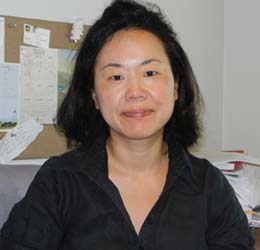
Linda Kim
In each testimony in the Visual History Archive, survivors have the opportunity to show photographs and family artifacts. Though this segment usually comes as a footnote of sorts at the end of each testimony, after the survivor has finished telling his or her story, it’s here that Linda Kim, a recipient of USC Shoah Foundation’s 2014 Teaching Fellowship, will focus her research this summer.
Kim teaches art history at Drexel University and is currently working on a project dealing with photographs of the Rwandan genocide. She was surprised to discover Rwandan Tutsi Genocide testimonies and photographs in the Visual History Archive alongside the Holocaust testimonies.
She said that much of the scholarship analyzing the visual representation of genocide argues that the photographs and films of the Holocaust serve as the lodestar for this crime—heightening our awareness of genocide's centrality in the twentieth century, but also obscuring other instances of it.
“One of the problems that scholars have identified with the media representation of the 1994 genocide against the Tutsi in Rwanda was its reputed exceptionalism—the ways in which it did not fit other historical examples of genocide,” Kim said. “The VHA's inclusion of the Rwandan material removes the Rwandan genocide from its epistemological isolation and opens up a space to study both the events of Holocaust and the Rwandan genocide in productive parallel and friction.”
USC Shoah Foundation’s Teaching Fellows program provides financial support and staff assistance to faculty members who wish to use the Institute’s life-history testimonies in their new or existing courses.
During her fellowship, Kim will research the uses of photography in the video testimonies of the survivors and witnesses for an anthropology course she’ll be teaching called Witness to Atrocity: Photography and Human Rights.
“Once you are prompted to look for photography in these videos, you realize how ubiquitous and varied photographs are in the testimonies. Sometimes the photographs appear as personal images culled from family albums; at other times, they are forensic photographs of the camps taken by the Nazis or the liberating armies,’ Kim said. “In each of these cases, the photographs enact a different kind of cultural work for the individual citing them.”
Kim said she hopes her course compels students to come into contact with history on a deep, interpersonal level.
“I hope students will learn how profoundly photography mediates our experiences – both first-hand and second- and third-hand instances provided by witnesses and survivors — and, perhaps, this realization may inspire a more careful scrutiny of how photographs mediate the next humanitarian crisis,” she said.